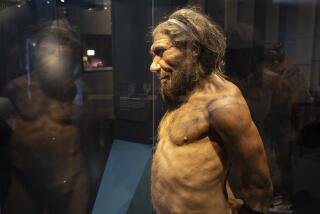Stripping Down to the Core of Sexuality : MYSTERY DANCE: On the Evolution of Human Sexuality, <i> by Lynn Margulis and Dorion Sagan,</i> Summit Books, $19.95, 215 pages
- Share via
“Is sex necessary?” wondered humorist James Thurber in his 1929 book of that title. Even before then, but increasingly since, scientists have been looking at sex. They’ve described the reproductive activity of nearly every living thing that moves on the Earth, not to mention many more that stand still.
What all this research adds up to--say the authors of this provocative and absorbing salvo in the war between the, uh, genders--is that the human female’s unique orgasm, prominent breasts, clitoris, hymen and concealed sexual desire have given modern women an evolutionary edge over men in sexual weaponry.
“In modern biology,” the authors write, “the male has lost his pride of place. Like his counterpart in society, he is being given over to the feminine whirlwind.”
This transfer of power, the authors say, took about 4 billion years. During the first 3 billion years, the Earth was ruled by slime molds, amoebas, algae and other primitive forms of life whose sexuality was as complicated as the organisms were simple. This vast early period of biological history is the specialty of co-author Margulis, a professor of biology at the University of Massachusetts, Amherst, and a member of the prestigious National Academy of Sciences. Sagan is a writer and artist.
The two collaborated on a previous book, “Microcosmos: Four Billion Years of Evolution From Our Microbial Ancestors,” which focuses chiefly on the pre-human period of evolution. The present work, “Mystery Dance,” condenses much of the earlier “Microcosmos” and extends it to treat more specifically the human female in evolution.
Like “Microcosmos,” “Mystery Dance” contains an intriguing, if tendentious, review of recent research in biology and animal behavior, as well as a smattering of fun facts, such as the length of an adult male gorilla’s erect penis (1 1/2 inches).
The authors’ key--and controversial--assumption in both books is that all the ancestors of contemporary humans--not only apelike proto-humans but also ancient reptiles and even the primordial slime molds--have left their mark.
To show how these unlikely sounding forebears influenced the design of today’s woman, the authors use a daring but ultimately mystifying device: a striptease dancer. The authors ask the reader to watch this “evolutionary stripper” peel off layer after layer of evolutionary development, revealing ever-earlier states of biological being.
The striptease metaphor is meant to show that the “Mystery Dance” is as much about human sexuality itself as it is about the evolution of the modern human female. The language of science suffices for discussing evolution, the authors argue, but it fails to capture the mysterious meaning of sex.
“Wet and slippery, sex does not fossilize well,” they write. To increase the sensitivity of their investigation, the authors invoke psychology as well as science, hoping to engage the reader’s body as well as mind.
Reading “Mystery Dance,” they say, “you slide between the covers of a bedlike book as you confront these ink-stained sheets. In a sense, this whole book is a . . . waking dream.”
Dreams are, of course, the province of Sigmund Freud and his followers. So not surprisingly, the influential neo-Freudians Jacques Lacan and Jacques Derrida, who launched the deconstructionist movement now rattling the humanities departments of American universities, take their place alongside the “evolutionary stripper.”
The show really gets under way when Margulis and Sagan unveil their capacious hospitality to avant-garde psychoanalytic ideas. Leather fetishism, for example, strikes the authors as a fortunate biological adaptation.
“The human fetish for leather,” they write, “may turn out to be useful . . . by solidifying human ties to cattle in herding societies fed by cowboy staples such as milk, butter, cheese and steak.”
Perhaps not everything in this rich, imaginative, but loosely executed book will appeal to all readers. Likewise, how it will serve the man-woman tussle is hard to predict. But “Mystery Dance” contains a fair amount of good science amid the nonsense, and it’s easy to tell the difference.
Next: Jonathan Kirsch reviews “Trees, Why Do You Wait?” by Richard Critchfield (Island Press) .
More to Read
Sign up for our Book Club newsletter
Get the latest news, events and more from the Los Angeles Times Book Club, and help us get L.A. reading and talking.
You may occasionally receive promotional content from the Los Angeles Times.








